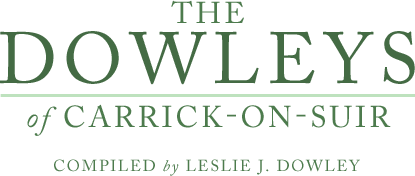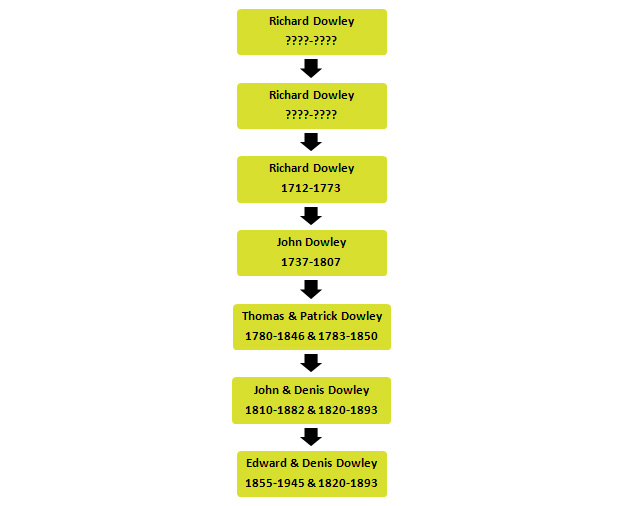The river Lignaun separates Co. Kilkenny in Leinster from Co. Tipperary in Munster and the Dowley mill was situated some 200 m upstream from the ford on the Killonerry bohreen. The mill was somewhat smaller than those built in the boom period of the late 1700’s.
It is believed that construction of the Dowley Mill on the Lignaun was started towards the latter end of the 1500’s and it is known that the Tinvane mill was in full production as early as 161011. It would have required considerable capital to build the mill and to harness the water from the river Linguan to drive the millwheel. Where the capital for this project came from is unknown and we are never likely to discover, as the original Dowley owners can’t be established with certainty. The first occupier may have been the same Richard “Dowly” that is listed in the Hearth Money Rolls of 1664 or more likely his father or grand-father. In 1664 there was also a Teigh Dowley of Figlassy (Figlash) which is only about 3 miles from Tinvane as the crow flies. However, his relationship to the Tinvane Dowleys is not known. The Dowleys were exclusively millers for the first 200 years. In the next 200 years they branched out into general trade in agricultural commodities as well as fuel and river transport. The Secretary of Research at The British Flour Milling Association has concluded that according to their records, the Dowley milling interest was probably the oldest in Britain or Ireland still operational and retained in full by the family of the original founder11.
The English civil war, in the middle of the 17th century, resulted in the execution of Charles 1st and the coming to power of the Parlimintarians where Oliver Cromwell and the “New Model Army” was one of the its main military forces16. In Ireland there was a lot of support for the monarchy by the Confederates. The Confederates were made up of Royalists, Irish Catholics, old English Catholics and some protestants. From 1641 onwards, the Confederates organised a number of successful rebellions in support of the Monarchy. The purpose of the Cromwellian invasion of 1649-1653 was to defeat the followers of the executed King of England led by the Marquis of Ormonde. Kilkenny city was the adopted capital of the Confederates.
Oliver Cromwell and his New Model Army set sail for Dublin on August 13th, 1649. He captured Dundalk in September and then Wexford. Having failed to take Duncannon Fort he moved on to take New Ross, the gateway to Munster. From there he marched westwards on the north side of the river Suir to take Carrick-on-Suir on November 20th. He then crossed the bridge in Carrick and marched on to Waterford on the south side of the river where he unsuccessfully laid seige to the city from November 24th to December 2nd. The armies over wintered in the Dungarvan Youghal area. In early 1650, a section of the army under general Ireton again marched through Carrick on their way to capture Callan on February 3rd.
Following the Cromwellian invasion much of the land in Ireland was confiscated in order to pay the soldiers in Cromwells army. According to O’Siochru (2008), Tipperary was one of the counties most sevely affected, with 77% of the county being coniscated.
As the original mill pre-dated the Cromwell invasion of 1649, it is likely that Dowleys were the owner occupiers at that time the mill was constructed. Following the invasion, the lands at Tinvane were granted to the Ponsonby family and through them to the Briscoes. The Dowleys appear to have been dispossessed as they became tenants of the Briscoe family.
The Tinvane mill was in existence for some 150 years when there was a major revival in the corn trade during the latter quarter of the 18th century. This, together with the Dowley involvement in the river trade would have conferred significant commercial advantages on the Dowley enterprises. The main beneficiaries in the revival of the corn trade would have been John Dowley (1737-1808) together with his two sons Thomas (1780-1846) and Patrick (1782-1850). The industrial revolution in England also increased the demand for grain and grain products from Ireland. The main beneficiaries in the continued export of grain and grain products would have been John (1810-1882) and his first cousin, Patrick John (1812-1872).
From the foregoing it is probable that the Dowleys made a lot of money between the years 1775 and 1850 approximately. This theory would be supported by the fact that John Dowley had sufficient liquid capital to invest heavily in Sadlier’s Bank or the Tipperary Joint Stock Bank founded by John Sadlier in 1838. The manager of the Carrick branch of this Bank in 1846 was one Clement Sadlier, a brother of the aforementioned John. Like the current banking crisis, the rapid increase in business was not well founded and the bank developed major trading difficulties. The Bank eventually went into receivership when John Sadlier committed suicide in Hyde Park, London in 1856. This had serious implications for John Dowley who was a major investor in the Bank. He was later declared “bankrupt” but appeared not to lose any of his property or businesses in Carrick.
John developed an alternative mill in New Street, Carrick-on-Suir in the mid 1800’s and gradually the importance of the Tinvane mill diminished. John died in 1882 and was succeed by his son Edward who in 1891 bought out the interests of the Briscoe family in the land and mill at Tinvane. We know that the mill was still in production in 1889 when they were grinding corn for Edward Dowley of New St. However, the New St. business seemed to be separate to the mill in Tinvane and this probably dates from the time John started his own business in the town of Carrick-on-Suir towards the middle of the 19th century.
The mill at Tinvane probably ceased production following the death of Denis Dowley in 1893. At the beginning of the 20th century it was adapted as an electricity generation station by Edward’s son Francis to supply power to Tinvane House now refurbished and occupied by Edward Dowley. By 2010 the mill at Tinvane had been demolished and has been replaced with a water treatment plant for Carrick-on-Suir Urban District Council.

The ford and footbridge across the Lingaun river below the Dowley Mill (2010)

The current (2010) entrance to Tinvane Mill. The house was on the left and mill on the right at the end of the entrance.

The mill stream at the current water treatment plant

The mill pond and water treatment plant that has replaced the old mill on the Lingaun
Leslie J. Dowley
lesdowley@eircom.net


Lived in Carrick until 1976. Have many memories of the Dowleys of Carrick.
Was in same class as Ray in the Monastery late sixties and found Ray to be a very quite unassuming guy.
Also,we were near neighbours of Florrie Dowley,Three bridges. I can remember going for walks with my parents
and often we would meet Florrie and have a chat.
Also,I remember in late sixties,Paddy Dowley paying us a visit on the! Saturday……following Sunday night he was killed in that horrific car crash on Tramore road outside Waterford.I remember hearing it broadcsst on Raidio
Eireann news on the Monday morning….we were in total shock. I’m also remember going down to Tramore and seeing the crashed VW beetle parked up. I also remember a prominent Waterford butcher Colm Molloy was killed
in that crash.